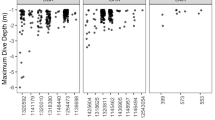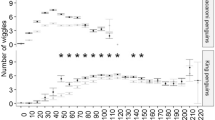Abstract
A new concept based on analysis of dive depth data was developed to help estimate prey consumption in ten free-ranging Magellanic penguins (Spheniscus magellanicus) that were brooding chicks. By simultaneously analysing the undulations in the dive depth profile (measured by time-depth recorders, TDRs) and beak opening (obtained from the recently developed intra-mandibular angle sensors, IMASEN), it was possible to determine the proportions of the undulations in the dive profile that resulted (or not) in prey capture. This methodology allowed the number of prey consumed to be estimated with a mean error of 10±6% using TDR data alone. If the mean mass of prey is known, then the overall mass of prey consumed per unit time can be determined. Additionally, the method allows estimation of the depth at which prey is taken and thus indicates how penguins exploit the water column. Due to its simplicity, the proposed methodology has applications for other Spheniscus penguin species and should be considered for other marine endotherm divers that show undulations in the dive depth profile.





Similar content being viewed by others
References
Bannasch R, Wilson RP, Culik B (1994) Hydrodynamic aspects of design and attachment of a back-mounted device in penguins. J Exp Biol 194:83–96
Bowsall J, MacIver D (1975) The Magellanic penguin Spheniscus magellanicus. In: Stonehouse B (ed) The biology of penguins. Macmillan, Bristol, pp 271–305
Denton EJ (1971) Reflectors in fishes. Sci Am 224:65–72
Duffy DC, Jackson S (1986) Diet studies of seabirds: a review of methods. Col Waterbirds 9:1–17
Frere E, Gandini P, Lichtschein V (1996) Variación latitudinal en la dieta del pingüino de Magallanes (Spheniscus magellanicus) en la costa patagónica, Argentina. Ornithol Neotrop 7:35–41
Harcourt RG, Schulman AM, Davis LS, Trillmich F (1995) Summer foraging by lactating female New Zealand fur seals (Arctocephalus forsteri) off Otago Peninsula, New Zealand. Can J Zool 73:678–690
Herling C (2001) Zusammensetzung und Energiegehalt der Beuteorganismen chilenischer Pinguine. Diplomarbeit, Christian-Albrechts-Universität zu Kiel, Kiel, Germany
Kirkwood R, Robertson G (1997) The foraging ecology of female Emperor penguins in winter. Ecol Monogr 67:155–176
Kooyman GL (1989) Diverse divers. Springer, Heidelberg Berlin New York
Le Boeuf BJ, Naito Y, Asaga T, Crocker D, Costa DP (1992) Swim speed in a female northern elephant seal: metabolic and foraging implications. Can J Zool 70:786–795
Le Maho Y (1994) New perspectives for research on Antarctic birds and mammals. Polar Biol 14:315–318
Luna-Jorquera G, Culik BM (1999) Diving behaviour of Humboldt penguins Spheniscus humboldti in northern Chile. Mar Ornithol 27:67–76
Martin AR, Smith TG, Cox OP (1998) Dive form and function in belugas Delphinapterus leucas on the eastern Canadian High Arctic. Polar Biol 20:218–228
McCafferty DJ, Boyd IL, Taylor RI (1998) Diving behaviour of Antarctic fur seal (Arctocephalus gazella) pups. Can J Zool 76:513–520
Mills K (2000) Diving behaviour of two Galápagos penguins Spheniscus mendiculus. Mar Ornithol 28:75–79
Radl A, Culik BM (1999) Foraging behaviour and reproductive success in Magellanic penguins (Spheniscus magellanicus): a comparative study of two colonies in southern Chile. Mar Biol 133:381–393
Rand RW (1960) The distribution, abundance and breeding habits of the Cape penguin (Spheniscus demersus) off the south western coast of the Cape Province. Invest Rep Div Fish Un S Afr 41:1–28
Ropert-Coudert Y, Baudat J, Bost C-A, Kato A, Le Maho Y, Naito Y (2000a) Validation of oesophagus temperature recording for detection of prey ingestion on captive Adélie penguins. Mar Biol 137:1105–1110
Ropert-Coudert Y, Sato K, Kato A, Charrassin J-B, Bost C-A, Le Maho Y, Naito Y (2000b) Preliminary investigations of prey pursuit and capture by King penguins at sea. Polar Biosci 13:101–112
Schreer JF, Kovacs KM, Hines RJO (2001) Comparative diving patterns of pinnipeds and seabirds. Ecol Monogr 71:137–162
Scolaro A, Wilson RP, Laurenti S, Kierspel M, Gallelli H, Upton JA (1999) Feeding preferences of the Magellanic penguin over its breeding range in Argentina. Waterbirds 22:104–110
Simeone A, Wilson RP, Knauf G, Knauf W, Schützendübe J (2002) Effects of attached data-loggers on the activity budgets of captive Humboldt penguins. Zoo Biol 21:365–373
Wilson RP (1984) An improved stomach pump for penguins and other seabirds. J Field Ornithol 55:109–112
Wilson RP (1985) Seasonality in diet and breeding success of the Jackass penguin Spheniscus demersus. J Ornithol 126:53–62
Wilson RP (1996) Foraging and feeding behaviour of a fledgling Magellanic penguin. Mar Ornithol 24:55–56
Wilson RP (2003) Fishing made easy: tips and tricks on decision on optimal foraging in Magellanic penguins Spheniscus magellanicus. In: Proceedings of the 23rd international ornithological congress, 11–17 August 2002, Beijing, China, (in press)
Wilson RP, Duffy DC (1986) Prey seizing in African penguins Spheniscus demersus. Ardea 74:211–214
Wilson RP, Liebsch N (2003) Up-beat motion in swimming limbs: new insights into assessing movement in free-living aquatic vertebrates. Mar Biol 142:537–547
Wilson RP, Wilson M-PT (1990) Foraging ecology of breeding Spheniscus penguins. In: Davis LS, Darby JT (eds) Penguin biology. Academic, San Diego, pp 181–206
Wilson RP, Wilson M-PT (1995) The foraging behaviour of the African penguin Spheniscus demersus. In: Dann P, Norman I, Reilly P (eds) The penguins. Surrey Beatty, Chipping Norton, pp 244–265
Wilson RP, Ryan PG, James A, Wilson M-PT (1987) Conspicuous coloration may enhance prey capture in some piscivores. Anim Behav 35:1558–1560
Wilson RP, Cooper J, Plötz J (1992) Can we determine when marine endotherms feed? A case study with seabirds. J Exp Biol 167:267–275
Wilson RP, Pütz K, Peters G, Culik BM, Scolaro JA, Charrassin JB, Ropert-Coudert Y (1997) Long-term attachment of transmitting and recording devices to penguins and other seabirds. Wildl Soc Bull 25:101–106
Wilson R, Ropert-Coudert Y, Kato A (2002a) Rush and grab strategies in foraging marine endotherms: the case for haste in penguins. Anim Behav 63:85–95
Wilson R, Steinfurth A, Ropert-Coudert Y, Kato A, Kurita M (2002b) Lip-reading in remote subjects: an attempt to quantify and separate ingestion, breathing and vocalisation in free-living animals using penguins as a model. Mar Biol 140:17–27
Yorio P, Frere E, Gandini P, Harris G (eds) (1998) Atlas de la distribución reproductiva de aves marinas en el litoral patagónico argentino. Instituto Salesiano de Artes Gráficas, Buenos Aires
Acknowledgements
This study was financed by ICSU under the auspices of SCAR to R.P.W. A.S. thanks the German Academic Exchange Service (DAAD) for a doctoral grant. We are particularly indebted to Silvina S. and the Consejo Agrario de Santa Cruz, Argentina, as well as to Antje, Pinocho, Leonor, José and Nieves for support, moral and otherwise.
Author information
Authors and Affiliations
Corresponding author
Additional information
Communicated by O. Kinne, Oldendorf/Luhe
Rights and permissions
About this article
Cite this article
Simeone, A., Wilson, R.P. In-depth studies of Magellanic penguin (Spheniscus magellanicus) foraging: can we estimate prey consumption by perturbations in the dive profile?. Marine Biology 143, 825–831 (2003). https://doi.org/10.1007/s00227-003-1114-8
Received:
Accepted:
Published:
Issue Date:
DOI: https://doi.org/10.1007/s00227-003-1114-8




